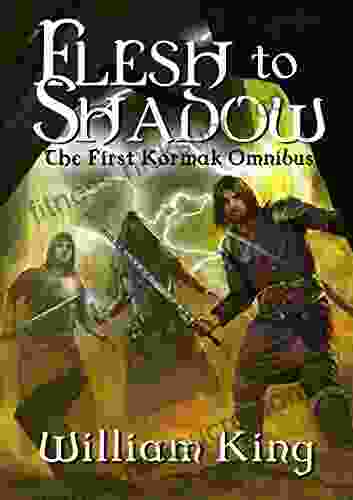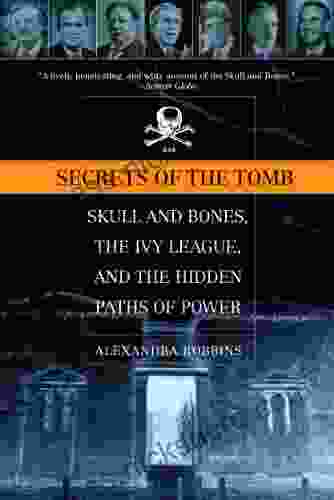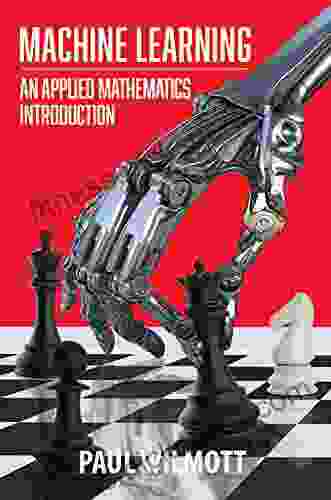Secrets Of The Tomb: Unraveling the Enigmas of Ancient Burials

Throughout history, tombs have served as enigmatic repositories of the dead, concealing secrets, treasures, and whispers of a forgotten past. From the grand pyramids of Egypt to the subterranean chambers of ancient Rome, these sepulchres have captivated the imagination of explorers and historians alike. In this comprehensive article, we delve into the fascinating world of tombs, unraveling their construction, purpose, and the intriguing stories they hold.
Origins and Evolution of Tombs
The concept of tombs emerged as early as the Neolithic era, when societies began to bury their deceased with reverence and care. Simple pits and caves served as the first rudimentary tombs, gradually evolving into more elaborate structures as civilizations progressed.
4.2 out of 5
| Language | : | English |
| File size | : | 771 KB |
| Text-to-Speech | : | Enabled |
| Screen Reader | : | Supported |
| Enhanced typesetting | : | Enabled |
| Word Wise | : | Enabled |
| Print length | : | 256 pages |
In ancient Egypt, tombs evolved from simple mastabas to towering pyramids, reflecting the pharaohs' belief in an afterlife. These colossal structures were designed to protect the bodies of the deceased and provide them with all the necessities for their eternal journey.
In ancient Greece and Rome, tombs took on a more diverse range of forms, including hypogea (subterranean chambers),tumuli (earthen mounds),and mausoleums (ornate above-ground structures). These tombs often featured intricate decorations, sculptures, and inscriptions, showcasing the artistic prowess and cultural beliefs of their time.
Construction and Architecture
The construction of tombs varied greatly depending on the civilization and the status of the deceased. While some tombs were simple excavations, others were monumental feats of engineering.
Egyptian pyramids were constructed using massive stone blocks, carefully quarried and transported to the construction site. The Great Pyramid of Giza, built for Pharaoh Khufu, boasts an estimated 2.3 million blocks, each weighing an average of 2.5 tons.
Roman tombs, such as the Mausoleum of Hadrian, employed advanced architectural techniques. The mausoleum featured a cylindrical base topped by a hemispherical dome, showcasing the Roman mastery of concrete construction.
Purpose and Significance
Tombs served multiple purposes beyond the simple burial of the deceased. They were seen as gateways to the afterlife, places where the dead could continue their existence in a spiritual realm.
Tombs also played a significant role in ancestor worship. By burying their loved ones in elaborate tombs, ancient societies believed they could honor their memory and maintain a connection with the deceased.
Moreover, tombs served as repositories of knowledge and cultural heritage. Inscriptions and murals within tombs often depicted historical events, religious beliefs, and everyday life, providing invaluable insights into the values, customs, and beliefs of past civilizations.
Treasures and Artifacts
Tombs have yielded countless treasures that shed light on ancient cultures and lifestyles. The discovery of Pharaoh Tutankhamun's tomb in 1922 revealed a wealth of gold, jewelry, and artifacts that had remained undisturbed for over 3,000 years.
The Terracotta Army of Xi'an, discovered in 1974, consists of thousands of life-sized terracotta warriors, horses, and chariots buried alongside the first emperor of China, Qin Shi Huang. This stunning discovery provides a glimpse into the grandeur and military prowess of ancient China.
Beyond precious metals and elaborate artifacts, tombs can also yield more modest yet equally valuable objects, such as pottery, tools, and everyday items that help us reconstruct the lives and customs of past societies.
Mysteries and Controversies
The allure of tombs lies not only in their tangible treasures but also in the mysteries and controversies that surround them. Many tombs have yielded enigmas that defy easy explanation.
The Great Pyramid of Giza, for instance, continues to be a subject of intense study and speculation. Its precise construction methods and the purpose of its internal chambers remain subjects of ongoing debate.
The tomb of Alexander the Great has been a source of fascination for centuries. Despite numerous expeditions, the exact location of his burial site remains a historical enigma.
Controversy also surrounds the discovery of the Dead Sea Scrolls, a collection of ancient Jewish religious texts found in caves near Qumran, Israel. The scrolls have sparked intense debate about their origins, authorship, and significance in biblical studies.
Modern Exploration and Preservation
In the modern era, the exploration and preservation of tombs have become important fields of scientific study. Archaeologists employ a range of techniques, including excavation, imaging, and DNA analysis, to uncover new knowledge about the past.
Advanced technologies, such as ground-penetrating radar and laser scanning, have significantly enhanced our ability to locate and study tombs without damaging their delicate structures.
Preservation efforts play a crucial role in safeguarding tombs for future generations. Conservationists work to stabilize and protect ancient burial sites, addressing threats such as moisture, pollution, and human disturbance.
Tombs, with their hidden treasures, enigmatic mysteries, and captivating stories, stand as enigmatic witnesses to the lives and beliefs of past civilizations. From the colossal pyramids of Egypt to the subterranean chambers of ancient Rome, these sepulchres continue to fascinate and inspire us. Through ongoing exploration, preservation, and research, we continue to unlock the secrets of the tomb, revealing invaluable insights into the human experience across time.
As we delve deeper into the mysteries of the past, we not only expand our knowledge but also forge a tangible connection with our ancestors, bridging the gap between the living and the dead.
4.2 out of 5
| Language | : | English |
| File size | : | 771 KB |
| Text-to-Speech | : | Enabled |
| Screen Reader | : | Supported |
| Enhanced typesetting | : | Enabled |
| Word Wise | : | Enabled |
| Print length | : | 256 pages |
Do you want to contribute by writing guest posts on this blog?
Please contact us and send us a resume of previous articles that you have written.
 Fiction
Fiction Non Fiction
Non Fiction Romance
Romance Mystery
Mystery Thriller
Thriller SciFi
SciFi Fantasy
Fantasy Horror
Horror Biography
Biography Selfhelp
Selfhelp Business
Business History
History Classics
Classics Poetry
Poetry Childrens
Childrens Young Adult
Young Adult Educational
Educational Cooking
Cooking Travel
Travel Lifestyle
Lifestyle Spirituality
Spirituality Health
Health Fitness
Fitness Technology
Technology Science
Science Arts
Arts Crafts
Crafts DIY
DIY Gardening
Gardening Petcare
Petcare Mark Harris
Mark Harris Matthew Bowling
Matthew Bowling David G Kingdon
David G Kingdon Minda Harts
Minda Harts Beccy Hands
Beccy Hands Damon Centola
Damon Centola Karin Slaughter
Karin Slaughter Frank Amthor
Frank Amthor Tim Weston
Tim Weston Sarah K L Wilson
Sarah K L Wilson David Wolman
David Wolman Mark Sisson
Mark Sisson Constantine A Balanis
Constantine A Balanis Mike Westin
Mike Westin Frank C Hawkins
Frank C Hawkins Alexis Averbuck
Alexis Averbuck Brigid Moss
Brigid Moss George S Fichter
George S Fichter Joel Weinberger
Joel Weinberger Lynne Robinson
Lynne Robinson Malina Malkani Ms Rdn Cdn
Malina Malkani Ms Rdn Cdn Frederick Courteney Selous
Frederick Courteney Selous Sir Oliver Lodge
Sir Oliver Lodge Charlie N Holmberg
Charlie N Holmberg Alexis C Bunten
Alexis C Bunten Jack Batten
Jack Batten Brian D Ambrosio
Brian D Ambrosio Roddy Scheer
Roddy Scheer Thomas Hund
Thomas Hund Rin Chupeco
Rin Chupeco Valora Conciencia En Los Medios
Valora Conciencia En Los Medios Jonathan Carroll
Jonathan Carroll Ali Velez Alderfer
Ali Velez Alderfer German Raigosa
German Raigosa Stephanie Mitchell Cnm Msn Dnp
Stephanie Mitchell Cnm Msn Dnp Mark C Purcell
Mark C Purcell Normandi Ellis
Normandi Ellis Lynne Cox
Lynne Cox Tim Maudlin
Tim Maudlin David Byrne
David Byrne Robert Zimmerman
Robert Zimmerman Charles Murray
Charles Murray Neil Schulenburg
Neil Schulenburg Rails To Trails Conservancy
Rails To Trails Conservancy Scott Chimileski
Scott Chimileski Sharon Powell
Sharon Powell Daniel Young
Daniel Young Richard Moore
Richard Moore Jenna Ortega
Jenna Ortega Roy Barth
Roy Barth Adah Bakalinsky
Adah Bakalinsky Michelle Rotteau
Michelle Rotteau Ken Mink
Ken Mink George Takei
George Takei Mark Rippetoe
Mark Rippetoe Kynan Bridges
Kynan Bridges Robin G Jordan
Robin G Jordan Lydia Wylie Kellermann
Lydia Wylie Kellermann Pantea Kalhor
Pantea Kalhor Nel Noddings
Nel Noddings Matthew Silverman
Matthew Silverman Hape Kerkeling
Hape Kerkeling William G Tapply
William G Tapply Christopher Steiner
Christopher Steiner Whitney Ferre
Whitney Ferre Alexandra Mayzler
Alexandra Mayzler G Pascal Zachary
G Pascal Zachary Norman L Keltner
Norman L Keltner Alfred Begum
Alfred Begum Joshua R Eyler
Joshua R Eyler Susan Albers
Susan Albers Alexei Yurchak
Alexei Yurchak Jeremy Hance
Jeremy Hance Daniel M Davis
Daniel M Davis Nick Mitchell
Nick Mitchell Dr Heather L Johnson
Dr Heather L Johnson Bear Grylls
Bear Grylls Keisuke Andrew
Keisuke Andrew Peter Flom
Peter Flom Mike Wallace
Mike Wallace Lara Alcock
Lara Alcock Larry Baush
Larry Baush Helen Hodgson
Helen Hodgson Lyanda Lynn Haupt
Lyanda Lynn Haupt Jessica Long
Jessica Long Crystal Waltman
Crystal Waltman Romina Garber
Romina Garber Reina Donovan
Reina Donovan Samantha Cattach
Samantha Cattach Jose Albani
Jose Albani Jay Greenberg
Jay Greenberg Martha Shirk
Martha Shirk Sarah Melland
Sarah Melland George Beinhorn
George Beinhorn Wendy Wood
Wendy Wood Heinrich Cornelius Agrippa Von Nettesheim
Heinrich Cornelius Agrippa Von Nettesheim Michael Clark
Michael Clark Kathy Barker
Kathy Barker Alice Borchardt
Alice Borchardt Jermaine Harris
Jermaine Harris Michael Vlessides
Michael Vlessides Malala Yousafzai
Malala Yousafzai Steve O Hearn
Steve O Hearn Stephen Ilg
Stephen Ilg Sarah Bolitho
Sarah Bolitho Philip Freeman
Philip Freeman Kirstin Cronn Mills
Kirstin Cronn Mills Leslie Anthony
Leslie Anthony Nick Littlehales
Nick Littlehales Eric Kaplan
Eric Kaplan Alexandra Robbins
Alexandra Robbins Sacha Black
Sacha Black Alexandra M Levitt
Alexandra M Levitt Anders Morley
Anders Morley Lola Glass
Lola Glass Mike Commito
Mike Commito Milly Buonanno
Milly Buonanno Jodi L Weinstein
Jodi L Weinstein Richard Preston
Richard Preston Sarah A Chrisman
Sarah A Chrisman Jeff Cooper
Jeff Cooper Becca Maberly
Becca Maberly Mary Kay Andrews
Mary Kay Andrews Stacey L Bradford
Stacey L Bradford Les Adams
Les Adams Andrew Zimmern
Andrew Zimmern Alice Walker
Alice Walker Steve Parker
Steve Parker Michael Thorp
Michael Thorp Virgil Herring
Virgil Herring Peter J Hotez
Peter J Hotez Mario Cleves
Mario Cleves Paul Asay
Paul Asay Jim Mclean
Jim Mclean Jon Moxley
Jon Moxley Eric Layton
Eric Layton Ernie Palladino
Ernie Palladino Zac Unger
Zac Unger Susan Jules
Susan Jules Dan Aadland
Dan Aadland Ali Almossawi
Ali Almossawi Robert P Crease
Robert P Crease Dan Jenkins
Dan Jenkins Courtney Kenney
Courtney Kenney Eric Siegel
Eric Siegel John Pagano
John Pagano Andy Kirkpatrick
Andy Kirkpatrick Erica Lyon
Erica Lyon Nancy Carpentier Brown
Nancy Carpentier Brown Karen Kovacs
Karen Kovacs Erika Rogers Holland
Erika Rogers Holland David Gessner
David Gessner Carol Chaitkin
Carol Chaitkin Ian Morris
Ian Morris Rachel Vitale
Rachel Vitale Alfred Tarski
Alfred Tarski William King
William King Mark Zondo
Mark Zondo Aram Attarian
Aram Attarian Emma Lock
Emma Lock Elan Golomb
Elan Golomb Helen Purperhart
Helen Purperhart Wendy Currie
Wendy Currie Anthony Legins
Anthony Legins Alexandria Moran
Alexandria Moran Ted Zeff
Ted Zeff Joshua Coleman Phd
Joshua Coleman Phd Jonathan Weiner
Jonathan Weiner Alfred Tennyson
Alfred Tennyson Laura Katz
Laura Katz Robert Kagan
Robert Kagan David Maidment
David Maidment Alexandra Heminsley
Alexandra Heminsley Sabina Khan
Sabina Khan Alice Horton
Alice Horton Howard Pyle
Howard Pyle Leslie Berlin
Leslie Berlin Karin Bojs
Karin Bojs Rev Cain
Rev Cain Paige Wolf
Paige Wolf Alexey Zimarev
Alexey Zimarev Pottermore Publishing
Pottermore Publishing Ryan Guldberg
Ryan Guldberg Jim Vance
Jim Vance Alice Gorman
Alice Gorman Tasha Alexander
Tasha Alexander Alice Miller
Alice Miller Theodore Roosevelt
Theodore Roosevelt Arthur Ashe
Arthur Ashe Avi Gordon
Avi Gordon Ron Ritchhart
Ron Ritchhart Mary Cholmondeley
Mary Cholmondeley Paul Green
Paul Green Carmindy
Carmindy Michael R Lindeburg
Michael R Lindeburg John Bemelmans Marciano
John Bemelmans Marciano Donna Bozzo
Donna Bozzo Nora Roberts
Nora Roberts Vishal Sambharya
Vishal Sambharya Margaret Starbird
Margaret Starbird Jeff Sambur
Jeff Sambur Andrew Yueh
Andrew Yueh Lisa Manterfield
Lisa Manterfield Brent Warner
Brent Warner Daniel Foor Phd
Daniel Foor Phd Said Hasyim
Said Hasyim Alice Jolly
Alice Jolly Carolyn Highland
Carolyn Highland Alina Adams
Alina Adams Lawrence Weschler
Lawrence Weschler Alice Kuipers
Alice Kuipers Zar Petkov
Zar Petkov Heather Lang
Heather Lang Yvette Marquez Sharpnack
Yvette Marquez Sharpnack Alfred Edersheim
Alfred Edersheim Dianna L Van Blerkom
Dianna L Van Blerkom Kathy Gunst
Kathy Gunst Neil J Salkind
Neil J Salkind Gary Wayne
Gary Wayne Lara Carter
Lara Carter Dean Pohlman
Dean Pohlman Amanda Ripley
Amanda Ripley Penelope Freed
Penelope Freed Bernie Clark
Bernie Clark David Travis
David Travis Sam Thoma
Sam Thoma Corky Pollan
Corky Pollan Lonely Planet
Lonely Planet Carl Erskine
Carl Erskine Dagny Scott Barrios
Dagny Scott Barrios Allison Saft
Allison Saft Jean Chatzky
Jean Chatzky Terry Marsh
Terry Marsh Karl Wiegers
Karl Wiegers Douglas Starr
Douglas Starr Jerry Lynch
Jerry Lynch Jen Noonan
Jen Noonan Guy Hunter Watts
Guy Hunter Watts Alexey Osadchuk
Alexey Osadchuk Paul Stephenson
Paul Stephenson Alice Nobile
Alice Nobile Bjorn Kjellstrom
Bjorn Kjellstrom Matthew Dektas
Matthew Dektas Dr C
Dr C Scott Linden
Scott Linden Thomas F King
Thomas F King Matthew Cowsert
Matthew Cowsert Mikel Jollett
Mikel Jollett Udo Schaefer
Udo Schaefer Patrick Torsell
Patrick Torsell Chip K
Chip K Melia Keeton Digby
Melia Keeton Digby Li Ming Lee
Li Ming Lee Grackle Pigeon
Grackle Pigeon Phillip Starr
Phillip Starr Nic Sheff
Nic Sheff Krissy Moehl
Krissy Moehl Kev Reynolds
Kev Reynolds Erez Morabia
Erez Morabia Kathleen Mcauliffe
Kathleen Mcauliffe Karen Mcquestion
Karen Mcquestion Arno Ilgner
Arno Ilgner Alice Roberts
Alice Roberts Eileen Edna Power
Eileen Edna Power Amy Pickar Abernethy
Amy Pickar Abernethy Crysta Mchenry
Crysta Mchenry Patti M Hummel
Patti M Hummel Penny Armstrong
Penny Armstrong Ben Applebaum
Ben Applebaum Complete Test Preparation Inc
Complete Test Preparation Inc Rob Price
Rob Price Sigurd F Olson
Sigurd F Olson Peter D Rogers
Peter D Rogers Christopher Mitchell
Christopher Mitchell David J Goldman
David J Goldman David Watson
David Watson Robert Lusetich
Robert Lusetich Arthur Robert Harding
Arthur Robert Harding Gen Tanabe
Gen Tanabe David J Rothman
David J Rothman Robert Scott
Robert Scott Dylan Farrow
Dylan Farrow Stuart Kauffman
Stuart Kauffman Judith Levin
Judith Levin David Armitage
David Armitage Alexandra Kennon
Alexandra Kennon Paul Wilmott
Paul Wilmott Alice June
Alice June Luke Reynolds
Luke Reynolds Wayne Stewart
Wayne Stewart Penny Warner
Penny Warner John C Hudson
John C Hudson M Mitchell Waldrop
M Mitchell Waldrop Doc Norton
Doc Norton Alice Scordato
Alice Scordato Susan Wise Bauer
Susan Wise Bauer Raymond Barrett
Raymond Barrett Scott Weems
Scott Weems Robin Kaplan M Ed Ibclc
Robin Kaplan M Ed Ibclc Tracy Anderson
Tracy Anderson Bassem R Mahafza
Bassem R Mahafza Daniel Goleman
Daniel Goleman Shaka Senghor
Shaka Senghor Shaun David Hutchinson
Shaun David Hutchinson Joe Proulx
Joe Proulx Carlton Kirby
Carlton Kirby Rebecca Schwarzlose
Rebecca Schwarzlose Emily Riehl
Emily Riehl Mary Beth Knight
Mary Beth Knight Sarah Rayner
Sarah Rayner Deborah Laird Meeks
Deborah Laird Meeks C S Johnson
C S Johnson Adrian Dingle
Adrian Dingle John Madieu
John Madieu Karyl Rickard
Karyl Rickard Eric Barker
Eric Barker Peter Gandy
Peter Gandy Ally Nathaniel
Ally Nathaniel Ali Novak
Ali Novak Thomas Horn
Thomas Horn Jill Simonian
Jill Simonian Tracy Becker
Tracy Becker Jessica Goodman
Jessica Goodman Jayson Georges
Jayson Georges Ashley Mardell
Ashley Mardell Gordon England
Gordon England Melissa Falkowski
Melissa Falkowski Ruby Vincent
Ruby Vincent Emily Levesque
Emily Levesque America S Test Kitchen
America S Test Kitchen Nick Kalyn
Nick Kalyn Louis Borgenicht
Louis Borgenicht Veronica O Keane
Veronica O Keane Charles Hainsworth
Charles Hainsworth Deborah Layton
Deborah Layton Mitchell P Jones
Mitchell P Jones Alexandra Bracken
Alexandra Bracken David A Askay
David A Askay Anna Mathur
Anna Mathur David G Alciatore
David G Alciatore Aris Spanos
Aris Spanos Eleanor Drago Severson
Eleanor Drago Severson John Abramson
John Abramson Joseph Henrich
Joseph Henrich Elizabeth Clare Prophet
Elizabeth Clare Prophet Jason Selk
Jason Selk Philip Rossoni
Philip Rossoni Robert L Kelly
Robert L Kelly Thao Doan
Thao Doan Alfred North Whitehead
Alfred North Whitehead Whitney Miller
Whitney Miller Robert A Monroe
Robert A Monroe Jim Walden
Jim Walden Stephen Blyth
Stephen Blyth Michael Cave
Michael Cave Henry Gilbert
Henry Gilbert Ryuu Shinohara
Ryuu Shinohara Roland Huntford
Roland Huntford Kevin Allen
Kevin Allen Kathryn A Bard
Kathryn A Bard Carmen Martinez Jover
Carmen Martinez Jover Michele Filgate
Michele Filgate John Lohn
John Lohn Glade B Curtis
Glade B Curtis Matilda Betham
Matilda Betham Richard H Coop
Richard H Coop Jay Golden
Jay Golden Joy S Kasson
Joy S Kasson Gabriel Aluisy
Gabriel Aluisy Carol Ekarius
Carol Ekarius Mark Kaplan
Mark Kaplan Frank J Tipler
Frank J Tipler Michael Patrick Ghiglieri
Michael Patrick Ghiglieri Stacy Tornio
Stacy Tornio Alexia Leachman
Alexia Leachman Alexis L Boylan
Alexis L Boylan Dustin Vaughn Warncke
Dustin Vaughn Warncke Josh Peter
Josh Peter Arthur Lydiard
Arthur Lydiard Peter Woit
Peter Woit Mike Dauplaise
Mike Dauplaise Duncan Hines
Duncan Hines Michael Vassallo
Michael Vassallo Hans Rosling
Hans Rosling Alexandra Brodsky
Alexandra Brodsky Suzanne Giesemann
Suzanne Giesemann Mary Johnson
Mary Johnson Ali Wong
Ali Wong Kenn Bivins
Kenn Bivins Lance Akiyama
Lance Akiyama Rosary O Neill
Rosary O Neill Alexis Marie Chute
Alexis Marie Chute Nancy Roe Pimm
Nancy Roe Pimm Sammy Hagar
Sammy Hagar Diana Hudson
Diana Hudson Alfie Kohn
Alfie Kohn Clay Bonnyman Evans
Clay Bonnyman Evans Alice Cooper
Alice Cooper Alice Boyes Ph D
Alice Boyes Ph D Natalie Angier
Natalie Angier Alice Steinbach
Alice Steinbach Michael J Behe
Michael J Behe Alice Beck Kehoe
Alice Beck Kehoe David A Ebert
David A Ebert Gary A Klein
Gary A Klein Hank D Haney
Hank D Haney Hollie Henderson
Hollie Henderson Katie Walsh Flanagan
Katie Walsh Flanagan Martha Sears
Martha Sears Jessica Riskin
Jessica Riskin Executivegrowth Summaries
Executivegrowth Summaries Darrin Gee
Darrin Gee Lindsay Grace
Lindsay Grace Alexandra Fuller
Alexandra Fuller Alfred Lambremont Webre
Alfred Lambremont Webre Shannon Messenger
Shannon Messenger Bayo Akomolafe
Bayo Akomolafe Joe Dolio
Joe Dolio Frank White
Frank White Alexia Purdy
Alexia Purdy Alicia Ranoldo
Alicia Ranoldo Ellen Kane
Ellen Kane Peter Collier
Peter Collier Craig S Brantley
Craig S Brantley David R Hawkins
David R Hawkins Michaelbrent Collings
Michaelbrent Collings Randy Spencer
Randy Spencer John F Gilbey
John F Gilbey Jane Gildart
Jane Gildart John G West
John G West Laura Gauld
Laura Gauld Jonny Bowden
Jonny Bowden Heather Baker
Heather Baker Thomas Hill
Thomas Hill Joeanna Rebello Fernandes
Joeanna Rebello Fernandes Peter Stark
Peter Stark Anymom
Anymom Judy Murray
Judy Murray Devyn Stone
Devyn Stone Michael Johnson
Michael Johnson Sue Tidwell
Sue Tidwell Jeremy Benson
Jeremy Benson Kimberly V Garner
Kimberly V Garner Paul H Frampton
Paul H Frampton Mark Elbroch
Mark Elbroch Heidi Murkoff
Heidi Murkoff Karin Perry
Karin Perry Patrick Ness
Patrick Ness Steven Pressfield
Steven Pressfield Suzy Amis Cameron
Suzy Amis Cameron Bob Toski
Bob Toski Pam Withers
Pam Withers Dawn Brookes
Dawn Brookes Seabury Blair
Seabury Blair Stephen Altschuler
Stephen Altschuler Ali Katz
Ali Katz Tom Mackie
Tom Mackie Yehuda Lindell
Yehuda Lindell Lauren Drain
Lauren Drain Penelope Leach
Penelope Leach Oivind Andersson
Oivind Andersson Hicham And Mohamed Ibnalkadi
Hicham And Mohamed Ibnalkadi Tim R Swartz
Tim R Swartz Michael Mcteigue
Michael Mcteigue John Pirillo
John Pirillo Peggy Vincent
Peggy Vincent Chase Kosterlitz
Chase Kosterlitz Vicki Manning
Vicki Manning Alice Sebold
Alice Sebold Lauren Harris
Lauren Harris Wade Davis
Wade Davis Sir E A Wallis Budge
Sir E A Wallis Budge Patricia A Mckillip
Patricia A Mckillip Alicia Puglionesi
Alicia Puglionesi K T Hanna
K T Hanna Eric Mantle
Eric Mantle
Light bulbAdvertise smarter! Our strategic ad space ensures maximum exposure. Reserve your spot today!
 Spencer PowellFollow ·16.5k
Spencer PowellFollow ·16.5k Allen ParkerFollow ·17.5k
Allen ParkerFollow ·17.5k Robert FrostFollow ·11k
Robert FrostFollow ·11k H.G. WellsFollow ·11.4k
H.G. WellsFollow ·11.4k Richard SimmonsFollow ·15k
Richard SimmonsFollow ·15k Glen PowellFollow ·2.7k
Glen PowellFollow ·2.7k Morris CarterFollow ·4.9k
Morris CarterFollow ·4.9k Neil GaimanFollow ·10.1k
Neil GaimanFollow ·10.1k

 Derek Bell
Derek BellReflections For Your Heart and Soul: A Journey of...
In the depths of...

 Joseph Conrad
Joseph ConradThe Heroines Club: Empowering Mothers and Daughters
The Heroines Club...

 Milan Kundera
Milan KunderaThe First Kormak Omnibus: A Literary Expedition into the...
Prepare to embark on an extraordinary literary...

 W.H. Auden
W.H. AudenThe Color Purple: A Journey of Love, Resilience, and...
The Color Purple, a groundbreaking novel...

 Harvey Hughes
Harvey HughesTemporal Anomalies and Replacement Theory: Unraveling the...
: The Enigma of Time Time,...
4.2 out of 5
| Language | : | English |
| File size | : | 771 KB |
| Text-to-Speech | : | Enabled |
| Screen Reader | : | Supported |
| Enhanced typesetting | : | Enabled |
| Word Wise | : | Enabled |
| Print length | : | 256 pages |














